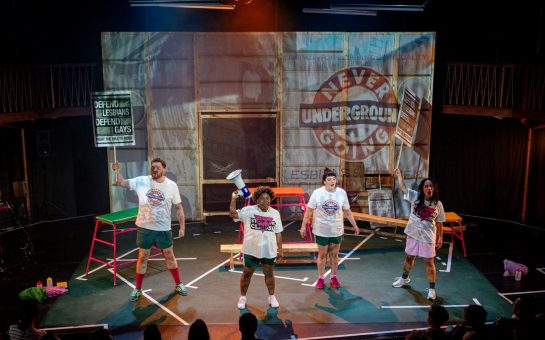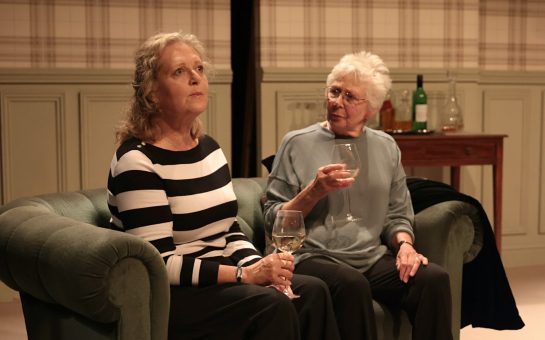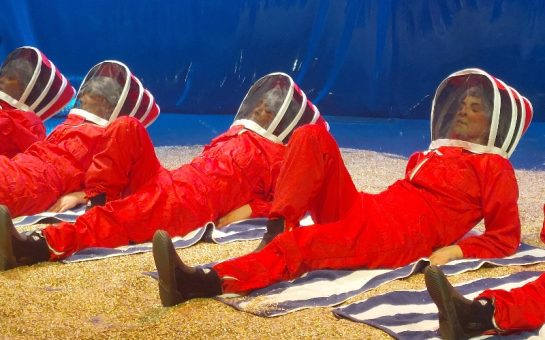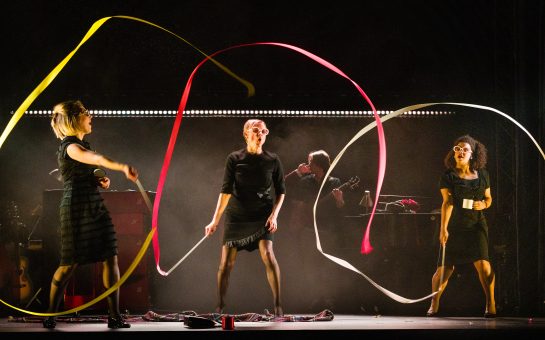Not many directors can boast of a BAFTA nomination for their debut feature length film, and not many can boast of also being in the running for a Turner Prize.
But not many people are Richard Billingham.
His debut feature Ray & Liz, a bleak memoir of his childhood in Birmingham, missed out on the BAFTA for Outstanding Debut for a British Writer, Director or Producer on Sunday night to Michael Pearce’s Beast.
Richard, 48, started out in photography, publishing his first collection – Ray’s A Laugh – in 1996, a series of photographs charting his mum Liz and dad Ray’s existence in their midlands council flat.
He also produced the documentary Fishtank for the BBC in 1998, a study of his father shot on a handheld camera. These laid the groundwork for Ray & Liz.
Understandably, Richard tells us that “if you’d said ‘you’re gonna get nominated’ whilst I was shooting the film I’d of never believed it. I’m surprised the film has managed to push through barriers.”
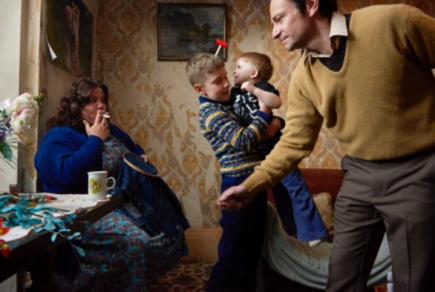
FAMILY PHOTO: Ella Smith as chain-smoking Liz and Justin Salinger as Ray
Across three vignettes he tells tales from the 70s and 80s of his uncle being manipulated by a lodger, his younger brothers adventures over a few days and his alcoholic Dad’s lonely existence years later.
It paints a compelling picture of 70s life that seems long forgotten – jars of beetroot, video nasties, and National Front graffiti – filling the film with an unflinching authenticity that is lost in many period pieces.
Richard explains the need to be careful not to step into self indulgence when portraying his own childhood, hence the focus on his brother Jason.
UNDERMINING SELFIES
“I didn’t want to put myself physically in it too much because I was scared of being self indulgent. You know, suggesting ‘look at poor me’. It could of been seen that way if I put myself in it too much.
“Also, I’ve made a lot of documentary photography and when I’ve looked at some other projects that documentary photographers have done, they’ve put themselves in it, you know they’ve photographed themselves looking in the mirror with the camera, all these selfies. I’ve noticed it tends to undermine the seriousness of the work.”
Reimagining and filming your own childhood comes with the obvious hurdle of emotional attachment to these memories, but this didn’t prove a problem.
“I think I was quite detached because it’s all so long ago. I’m nearly 50 now, it’s going back 30/40 years, there’s an element of detachment.
“My parents died 12 years ago in close succession, within six months of each other. I think I’ve taken a long time to start the writing process because maybe I needed to be this age to see my childhood and the way my family lived in context.”
The look of the film was very important to Richard, as it would be when penning your own childhood. Shot on stunning 16mm film, in a tight 3/4 format, Richard intended the shots to have a nostalgic feel.
“If you want to go back in time, I thought it made sense to use the medium of that time.
“I mean I did think about using video but I thought maybe that the constant awareness of the digital technology might undermine the time shifts.”
On the format he adds: “I know from making documentary photography that a smaller, more square frame can focus on objects and portraits and faces. Nearly all my landscape photography is panoramic, but I noticed that it’s very good for landscapes but if you want to focus on an object it’s a bit difficult.
Had the pleasure of watching the preview of Ray & Liz last night at @HOME_mcr with Richard Billingham and @Jacqui__Davies. A beautiful portrait! pic.twitter.com/mduIF0bmUy
— Molly Beecham (@beecham_molly) February 5, 2019
“The other reason for using 3/4 – that was the technology of the time. When I was growing up in the 70s and 80s all the TV’s were that aspect ratio.”
Normally Richard also shoots his photography analogue, but a recent project has moved him to digital.
“Analog is very good at rendering natural textures like paper, cardboard, wood, cotton things like that. I use analog mostly but I’ve started to use a digital camera to make photographic portraits of homeless people that I encounter on the street.
“The digital camera is very good for this because it can render plastic artificial surfaces really well.
“What the homeless people wear now is all outdoor material like what you climb Mount Everest with or something, it’s not natural fabric and they have pre-packed sandwiches given to them in plastic and a Starbucks coffee cup, McDonalds hamburgers in polystyrene.
“But the digital is really good for rendering those modern materials, I think analogue photography is better at natural materials so that was another reason (for shooting Ray & Liz on 16mm).”
‘WHAT’S THE NATIONAL FRONT?’
The attention to detail goes much further than just the camera work. The locations, set design and soundtrack have just as much thought poured over them.
“I shot as much as possible in original locations, where events took place.”
Gaining permission to shoot in the original locations was the easy part, covering the walls in National Front graffiti and glue bags proved much harder.
“That’s what you saw everywhere and there should of been more of it, it’s just very difficult to get permission to spray that stuff on the walls.
“I remember when I lived in the tower block, every square inch of wall space in the corridors and on the stairway was covered in graffiti, most of it racist.
“It was very intimidating when you walk in, but you get used to it. I wanted to show that but you just couldn’t get permission to do it because it looks offensive.
“Smashed windows everywhere, glass on the floor, piss and shit in the corridors and the lifts, it was terrible.”
“It was quite funny, there’s a bit shot in the graveyard, where Jason walks through the graveyard, I said ‘Can we spray Black Sabbath on that cross, scatter some glue bags in the grass and I want NF there and something else there.’
“And this person was taking notes and she came up to me at the end and said: ‘What is a glue bag? What is NF?’ Because the younger generation don’t know what all that means, but it was important to me and I would of had a lot more because that’s how it was.”
The television proves another portal to a different time, singer Toyah Wilcox dons the screen early on and 1984 horror film Children of the Corn makes an appearance later, but Richard had different ideas for this scene.
“What I really wanted was An American Werewolf in London, that really was part my childhood, a real period piece, I’ve watched that many, many times.
“But I think something like seven different people own bits of that film, and then there’s different people that own the songs, it was just too hard to get the copyright, but I would of chosen that.
“But Children of the Corn sort of works as well, I think it matches the wallpaper.
“We needed something quite scary on the TV, when I was a kid there were video nasties and horror films with the big argument over whether kids should be watching them.
“I wanted Jason to see something quite scary, I guess that’s why he gets creeped out at night walking home, because he’s seen the film.”
All this isn’t packed in for nostalgic brownie points though, it feels eerily authentic. It doesn’t glorify any of these details, but rather weaves them seamlessly into the narrative, leaving the audience fully immersed into the life of the 1970s council flat.
Television played a big part in Richard’s early life, so much so that him and his brother Jason referred to it as the “the life support machine.”
It wasn’t until slightly later in life however, that films became more important to Richard, he speaks fondly of Terence Davies, particularly his trilogy – Children, Madonna and Child and Death and Transfiguration.
“That film (The Terence Davies Trilogy) has been the most inspirational film that I can think of. I remember watching it when I was 25, it was like looking at his memories.
“It was quite slow, but it was very tense at the same time, it was quite static in a way but still very tense. He focused on faces and objects.
“I remember when I was a kid I watched this film called A Man Escaped, a Robert Bresson film. When I was a kid they put black and white films on the telly, I grew up with Laurel and Hardy and Harold Lloyd, lots of black and white movies, they just don’t put those things on now.
“This film A Man Escaped, about a man in a room, and I was very surprised watching it as a kid, nearly all the shots were inside this one prison cell but it was still tense.
“Apart from that, there’s no other film I can think of that directly influenced the making of this.”
Richard didn’t start with the intention to make a feature length film, and the process to get it to this length has been a few years coming.
“It started off gradually, for many years I had this idea that I wanted to make a short gallery piece, called Ray that would be about a man in a room, like that Bresson film.
“A few years ago me and Jacqui Davies (the producer), we got funding to make this short piece to chart two to three days of my fathers existence in this room.
“So I was making that, I decided to write another short piece about my uncle Laurence and Will (the lodger) and I thought maybe this could make another short film, so I wrote that down.
“Then I realised if I could write another one I’d have a feature length piece. So it evolved that way, I didn’t decide to make a feature one day, it evolved, it grew from the bottom up.”
We won’t be waiting as long for his next feature, Richard is hoping for Ray & Liz to jumpstart his film career much like Ray’s A Laugh did for his photography.
“I’m writing more material, but different subject matter. There might be similar themes but it wouldn’t be autobiographical it will be more external.”
With a BAFTA nomination already under his belt, the future looks bright for Richard, and we can only hope his next work is as much of a hit.
Ray & Liz opens at HOME, Manchester from March 8.
